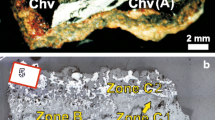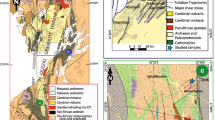Abstract
Very high temperature, Ca-rich alkaline magma intruded an argillite formation at Colle Fabbri, Central Italy, producing cordierite-tridymite metamorphism in the country rocks. An intense Ba-rich sulphate-carbonate-alkaline hydrothermal plume produced a zone of mineralization several meters thick around the igneous body. Reaction of hydrothermal fluids with country rocks formed calcium-silicate-hydrate (CSH), i.e., tobermorite-afwillite-jennite; calcium-aluminum-silicate-hydrate (CASH) — “cement” phases - i.e., thaumasite, strätlingite and an ettringite-like phase and several different species of zeolites: chabazite-Ca, willhendersonite, gismon-dine, three phases bearing Ca with the same or perhaps lower symmetry of phillipsite-Ca, levyne-Ca and the Ca-rich analogue of merlinoite. In addition, apophyllite-(KF) and/or apophyllite-(KOH), Ca−Ba-carbonates, portlandite and sulphates were present. A new polymorph from the pyrrhotite group, containing three layers of sphalerite-type structure in the unit cell, is reported for the first time. Such a complex association is unique. Most of these minerals are specifically related to hydration processes of: (1) pyrometamorphic metacarbonate/metapelitic rocks (natural analogues of cement clinkers); (2) mineralization between intrusive stocks and slates; and (3) high-calcium, alkaline igneous rocks such as melilitites and foidites as well as carbonatites. The Colle Fabbri outcrop offers an opportunity to study in situ complex crystalline overgrowth and specific crystal chemistry in mineral phases formed in igneous to hydrothermal conditions.
Similar content being viewed by others
References
Stoppa F., L’euremite di Colle Fabbri (Spoleto): Un litotipo ad affinità carbonatitica in Italia. Bollettino. Società Geologica Italiana, 1988, 107, 239–248
Stoppa F., Rosatelli G., Ultra-mafic intrusion triggers hydrotermal explosions at Colle Fabbri (Spoleto, Umbria), Italy, J. Volcanol. Geoth. Res., 2009, 187, 85–92
Stoppa F., Sharygin V.V., Melilitolite intrusion and pelite digestion by high temperature kamafugitic magma at Colle Fabbri, Spoleto, Italy, Lithos, 2009, 112, 306–320
Stoppa F., Cundari A., Rosatelli G., Woolley A.R., Leucite melilitolites in Italy: Genetic aspects and relationship with associated alkaline rocks and carbonatites, Periodico di mineralogia, 2003, 72, 223–251
Stoppa F., Rosatelli G., Principe C., Le vulcaniti del Monte Vulture, classificazione modale e considerazioni seriali. In: Principe C. (Ed.) La geologia del Monte Vulture. Regione Basilicata, Dipartimento Ambiente, Territorio e Politiche della Sostenibilità, Lavello 2006, 87–104
Stoppa F., Sharygin V.V., Nyerereite from carbonatite rocks at Vulture volcano: implications for mantle metasomatism andpetrogenesis of alkali carbonate melts. Central European Journal of Geosciences, 2009, 1, 131–151
Ding J., Fu Y., Beaudoin J.J., Strätlingite formation in high-alumina cement-silicate fume systems: Significance of sodium ions. Cement Concrete Res., 1995, 25, 1311–1319
Macphee E. D., Barnett S.J., Solution properties of solids in the ettringite-thaumasite solid solution series., Cement Concrete Res., 2004, 34, 1591–1598
Shimada Y., Young J.F., Thermal stability of ettringite in alkaline solutions at 80° C., Cement Concrete Res., 2004, 2261–2268
Passaglia E., Galli E., Vertumnite, a new natural silicate. Tschermaks Mineralogiche und Petrografische Mitteilungen, 1977, 24, 57–66
Passaglia E., Turioni B., Silicati ed altri minerali di Montalto di Castro (Viterbo), R.M.I. (please expand the acronime), 1982, 4, 97–110
Schüller W., Betz V., Die mineralien vom Emmelberg, Lapis, 1986, 11, 11–25
Taucher J., Von Hollerer C.E., Ein Ca-reicher Xenolith aus dem Basaltsteinbruch Kloch, Nordlicher Bruch, Klocher Klause (Steiermark, Osterreich). Mitt. Naturwiss. Ver. Steiermark, 2000, 130, 19–30
Baumgärtl U., Cruse B., Die Mineralien der Vulkaneifel, Aufschluss, 2007, 58, 257–400
Gross S., The mineralogy of the Hatrurim Formation, Israel, Geol. Surv. Isr. Bull., 1977, 70, 1–80
Sharygin V.V., Sokol E.V., Vapnik Y., Minerals of the pseudobinary perovskite-brownmillerite series from combustion metamorphic larnite rocks of the Hatrurim Formation, Israel, Russ. Geol. Geophys., 2008, 49, 709–726
Barker D.S., Nixon P.H., High-Ca, low alkali carbonatite volcanism at Fort Portal, Uganda, Contrib. Mineral. and Petr., 1989, 130, 166–177
Wheeler S., Spigarelli S., Stoppa F., Rinaldi R., Secondary minerals from the igneous complex of Colle Fabbri, Spoleto (PG), Plinius, 1996, 16, 211–212
Hentschel G., Die Lavaströme der Graulai: eine neue Fundstelle in der Westeifel, Lapis, 1993, 18, 11–23
Bruker, SAINT v7.60A. Bruker AXS Inc., Madison, Wisconsin, USA, 2009
Sheldrik G. M., SADABS, University of Göttigen, Germany, 2002
Sheldrik G. M., XPREP, University of Göttigen, Germany, 2007.
Bonaccorsi E., Merlino S., Calcium silicate hydrate (CSH) minerals: Structures and transformations, 32nd International Geological Congress, Florence, Italy, 20–28 August 2004, Abstract Volume, 2004, 215 F. Stoppa, F. Scordari, E. Mesto, V.V. Sharygin, G. Bortolozzi
Bonaccorsi E., Merlino S., Kamph A. The crystal structure of tobermorite 14 Å (plombierite), a C-S-H phase, J. Am. Ceram. Soc., 2005, 88, 505–512
Parry J., Wright F.E., Afwillite, a new hydrous calcium silicate, from Dutoitspan Mine, Kimberley, South Africa. Mineral. Mag., 1925, 20, 277–285
Zhou Q., Lachowski E.E., Glasser F.P., Metaettringite, a decomposition product of ettringite. Cement Concrete Res., 2004, 34, 703–710
Edge R.A., Taylor H.F.W., Crystal Structure of Thaumasite, [Ca3Si(OH)6 12H2O](SO4) (CO3), Acta Cryst., 1971, B27, 594
Rinaldi R., Sacerdoti M., Passaglia E., Strätlinigite: crystal structure, chemistry and a re-examination of its polytype vertumnite, Eur. J. Mineral., 1990, 2, 841–849
Galli E., Passaglia E., Vertumnite: Its crystal structure and relationship with natural and synthetic phases, Tschermacks Min. Petr. Mitt., 1978, 25, 33–46
Coombs D.S., Alberti A., Armbrutser T., Artioli G., Galli E., Grice J.D., Liebau F., Minato H., et al., G. Recommended nomenclature for zeolite minerals: Report of the subcommittee on zeolites of the international mineralogical association, commission on new minerals and mineral names. The Canadian Mineralogist, 1997, 35, 1571–1606
Mazzi F., Galli E., The tetrahedral framework of chabazite. Neues Jahrb. Mineral., Monatsh., 1983, 461–480
Gottardi G., Galli E., Natural Zeolites, Springer-Verlag, Berlin, 1985
Stoppa F., Sharygin V.V., Cundari A., New mineral data from the kamafugite-carbonatite association: The melilitolite from Pian di Celle, Italy. Miner. Petrol., 1997, 61, 27–45
Postl W., Walter F., Tetranatrolith aus dem Basaltbruch Stürgkh-Hrusak in Klöch, Steiermark. In: Niedermayr G, Postl W, Walter F., Eds., Neue Mineralfunde aus österreich XXXIV, Carinthia II, 1985, 175, 250
Blass G., Graf H.W., Neufunde von bekannten Fundorten (VIII), Mineralien-Welt, 1993, 5, 41–48
Rinaldi R., Pluth J.J., Smith J.V., Zeolites of the phillip-site family. Refinement of the crystal structures of phillipsite and harmotome, Acta Crystallogr., 1974, D.30, 2426–2433
Gualtieri A.F., Accurancy of XRPD OPA using the combined Ritveld-RIR method. J. Appl. Crystallogr., 2000, 33, 267–278
Gatta G.D., Cappelletti P., Rotiroti N., Slebodnick C., Rinaldi R., New insights into the crystal structure and crystal chemetry of the zeolite phillipsite. Am. Mineral., 2009, 94, 190–199
Passaglia E., Pongiluppi D., Rinaldi R., Merlinoite, A new mineral of the zeolite group. Neues Jahrb. Mineal., Monatsh., 1977, 355–364
Moore A.E., Taylor H.F.W., Crystal Structure of Ettringite, Acta Cryst., 1970, B26, 386
Steefela C.I, Lichtnerb P.C., Multicomponent reactive transport in discrete fractures II: Infiltration of hyperalkaline groundwater at Maqarin, Jordan, a natural analogue site, J. Hydrol., 1998, 209, 200–224
Suzuki S., Sinn E., 1.4 nm tobermorite-like calcium silicate hydrate prepared at room temperature from Si(OH)4 and CaCl2 solutions, J. Mater. Sci. Lett., 1992, 12, 542–544
Diamond S., White J.L., Dolch W.L., Effects of isomorphous substitution in hydrothermally-synthesized tobermorite, Am. Mineral., 1966, 51, 388–401
Eytier C., Eytier J.R., Favreau G., Devouard B., Vigier J., Minéraux de pyrométamorphisme de Lapanouse de Severac (Aveuron), Cahier des Micromonteurs, 2004, 85, 3–32
Favreau G., Meisser N., Chiappero P.J., Saint-Maime (alpes-de-Haute-Provence): Un Exemple de pyromé-tamorphisme en région provençale, Cahier des Micromonteurs, 2004, 85, 59–91
Capitanio F., Comment on Melluso et al. (2003). The Ricetto and Colle Fabbri wollastonite and melilite-bearing rocks of the central Apennines, Italy, Am. Mineral., 2005, 90, 1934–1939
Stoppa F, Rosatelli G., Cundari A., Castorina F., Woolley, A.R., Comments on Melluso et al. (2003) and their reported data and interpretation of some wollastonite- and melilite-bearing rocks from the Central Apennines of Italy, Am. Mineral., 2005, 90, 1919–1925
Peacor D.R., Dunn P.J., Simmons W.B., Tillmanns E., Fisher R.X., Willhendersonite, a new zeolite isostructural with chabazite, Am. Mineralogist, 1984, 69, 186–189
Tillmanns E., Fischer R.X., Baur W.H., Chabazite-type framework in the new zeolite willhendersonite. Neues Jahrb, Mineral. Monatsh., 1984, 547–558
Stoppa F., Lloyd F.E., Rosatelli G., CO2 as the propellant of carbonatite-kamafugite cognate pairs and the eruption of diatremic tuffisite. Periodico di Mineralogia, Special Issue, Eurocarb, 2003, 72, 205–222
Steefela C.I, Lichtnerb P.C., Multicomponent reactive transport in discrete fractures II: Infiltration of hyperalkaline groundwater at Maqarin, Jordan, a natural analogue site. J. Hydrol., 1998, 209, 200–224
Author information
Authors and Affiliations
About this article
Cite this article
Stoppa, F., Scordari, F., Mesto, E. et al. Calcium-aluminum-silicate-hydrate “cement” phases and rare Ca-zeolite association at Colle Fabbri, Central Italy. Cent. Eur. J. Geosci. 2, 175–187 (2010). https://doi.org/10.2478/v10085-010-0007-6
Received:
Accepted:
Issue Date:
DOI: https://doi.org/10.2478/v10085-010-0007-6




